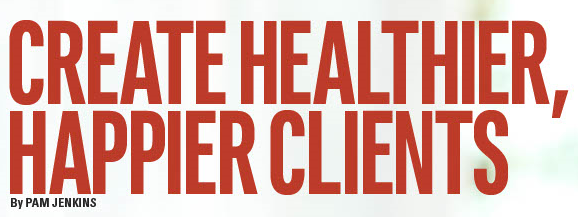
Boost your clients’ bottom line with wellness programs, including prescription discounts
By Pam Jenkins
Your clients have a lot of stress in their lives: Deadlines. Conflicting priorities. Budgetary pressures. Difficult customers. But are they worrying about their employees, who are also coming to work significantly stressed out?
They should be, because it’s costing them millions of dollars.
A new survey of U.S. consumers by Colonial Life showed more than 40% of workers battle high to moderate stress. The same number of employees say stress makes them less productive and 33% say it reduces their engagement at work. In fact, more than one in five—22%—say they spend more than five hours of work time every week worrying. That’s five hours when they’re not getting much done, or possibly making mistakes because they’re distracted by constant nagging thoughts.
What are they worried about? The big buckets are money and health—their own, or the health of a spouse, partner or children. That might not be surprising, and the good news is, there’s a great solution. That’s because there are products, services and resources you can bring your clients to help their employees improve their wellbeing and avoid or at least better deal with stress.
A successful wellness program can be measured in fewer sick days, reduced occurrences of preventable chronic conditions, a more positive work environment, increased productivity and higher employee retention rates due to improved morale. Estimates vary, but studies generally show a return of at least three-to-one for every dollar a company invests in a wellness program.
A healthier workforce also helps the bottom line by stemming the constantly rising costs of healthcare for both your clients and their employees. Healthier employees spend less on doctor’s office co-pays, prescriptions and other treatments that may not be covered by medical insurance until they meet their deductibles.
Four components of employee wellbeing
A comprehensive, effective employee wellness program covers much more than helping employees prevent colds, lose weight and stop smoking. Wellbeing encompasses physical, financial, mental and emotional health. These areas of wellbeing also overlap and interact: Remember our survey showed money is one of the top causes of employee stress—stress can lead to physical health problems.
Truthfully, many employers do focus on physical health, or at least tackle it first. An Optum survey of employers showed 56% have made changes to their workplace environment, mostly centered on getting employees to eat better and move more. Top changes included healthier food in vending machines and cafeterias, onsite fitness centers, ergonomic programs and smoking bans.
You may be thinking all this sounds great if my clients were all larger companies with significant budgets to invest in wellness. But very few have the resources to build a new gym onsite, for example.
The good news is, they don’t have to. There are many wellness-related benefits you can bring to your clients to help ensure a healthier, happier, more productive workforce. And many are available at low or no cost from your benefits partners, especially if you’re bringing them a new account or can ensure optimal enrollment conditions.
Pad your portfolio with wellness benefits
Start thinking of wellness programs as essential products your clients should include in their benefits packages. Consider these top wellness programs and services to address all four aspects of wellbeing—and again, many of these come with a low or zero price tag for either your clients or their employees:
- Wellness benefits embedded in insurance plans. Some voluntary coverages such as cancer policies include wellness benefits that pay a set amount for preventive screening tests such as colonoscopies, mammograms and X-rays. This helps catch potential problems earlier, when they’re easier and less expensive to treat. The benefits paid for annual screening tests also make the coverage even more affordable, in effect reducing the net cost of the premiums for employees. The benefit is paid even if the exam is covered by health insurance and the amount doesn’t depend on the actual cost of the test.
- Telemedicine. This increasingly popular service provides access to board-certified doctors online or by phone, any time of the day or day of the week. It’s not designed to handle emergency conditions or replace a primary care doctor, but it can often substitute for a doctor’s office or urgent care visit for common conditions such as the flu or pink eye — saving employees valuable time and money. This capability has also helped rural communities that have less access to health facilities.
- Discounts on drugs and medical services. A discount program can help employees save money on doctor office visits, prescription drugs, vision and hearing products and services, lab work and imaging tests. Even if your client already offers a health or prescription drug plan, a discount program can complement it by helping pay for services that are limited or not covered. This is especially true with a high-deductible health plan that leaves employees with considerable financial exposure to out-of-pocket costs.
- Identity monitoring and restoration. Nearly 60 million Americans were affected by identity theft last year, according to a Harris Poll survey reported on LifeLock.com—four times the number reported just a year earlier. Identity theft protection provides identity monitoring and helps employees with the burden of recovering from identity theft. It may include a dedicated case manager to act on the victim’s behalf and resolve the issue. Some packages even include a service to make lost wallet replacement quick and easy.
- Financial education. Many of America’s workers don’t understand basic financial concepts, according to a survey by GoBankingRates.com. A financial education program can include access to online calculators, budgeting tools, videos and webinars, plus unlimited access to complimentary financial coaching by phone.
- Student loan reimbursement support. Many recent graduates are spending a large percentage of their disposable income on student loan repayment. Some studies show millennials are more interested in student loan help than health care or retirement funding. And because of debt obligations, millennials are prone to job-hopping in search of extra income. Some programs allow employees to manage their student loan burden, refinance their debt or help find creative ways to pay down the burden. Employers who are really interested in keeping millennial employees engaged and loyal are even able to contribute to employees’ student loan debt payment.
- Employee assistance programs. EAPs provide short-term counseling and referral services to help employees with personal and family issues and work/life balances. Services typically include in-person, phone or online counseling and other online tools and educational resources that help with everyday life and decisions. Some carriers include EAPs in their insurance plans (such as Term Life) to offer additional benefits and incentives to purchase.
They Don’t Use What They Don’t Understand
Even the best wellness programs won’t deliver the results you promise and your clients expect—unless employees see their value and choose to participate in them. You can help drive stronger engagement with wellness programs by implementing a strong education and communication plan as part of the enrollment.
By implement, I really mean partner. Connect with a top benefits carrier that offers a full slate of enrollment services, including personalized benefits education and one-to-one benefits counseling. Partner with the carrier AND the employer to develop a communication campaign. Consistent wellness messaging, delivered in a variety of methods that work best for each client’s workplace, will help employees better understand the importance of wellness and how it can improve their lives—and save them money. Partner with the carrier AND the employer to develop a communication campaign. Many top carriers have templates that can be branded for your particular clients, and can include incentives to get employees to take action. If no communication materials exist, your partners may be open to the idea of developing these in a creative but cost-effective way.
Wellness programs are nothing to stress over. You can create stronger client relationships and expand your business by bringing these solutions to your clients of all sizes. Encouraging them to take advantage of easily available wellness programs and services can help them save money and create a happier, more productive workforce.

Pam Jenkins is the assistant vice president for product development at Colonial Life & Accident Insurance Company. She can be reached at pljenkins@coloniallife.com or 1 (803) 678-6220. Find her on LinkedIn here: https://www.linkedin.com/in/pam-jenkins-b807392/
